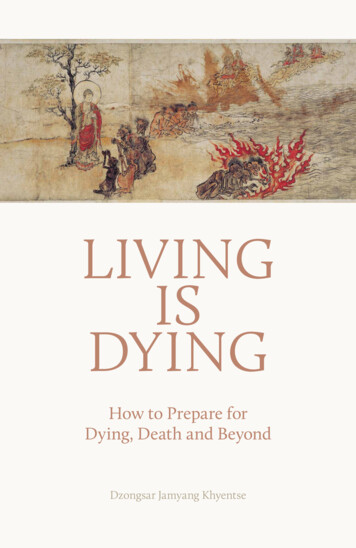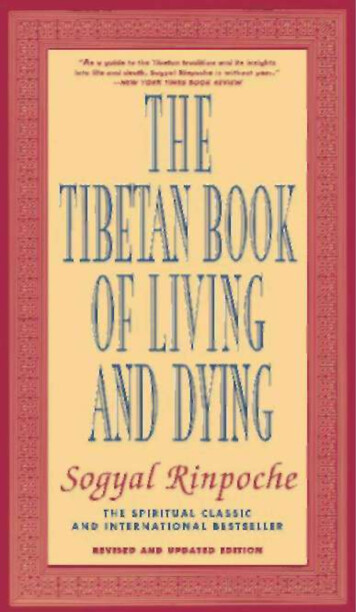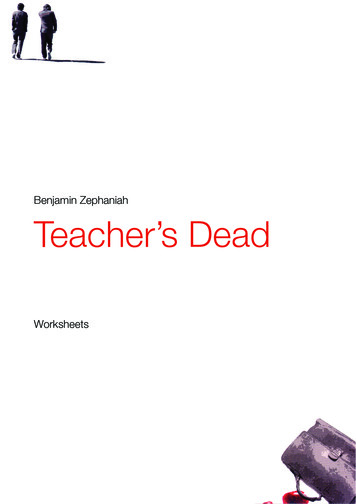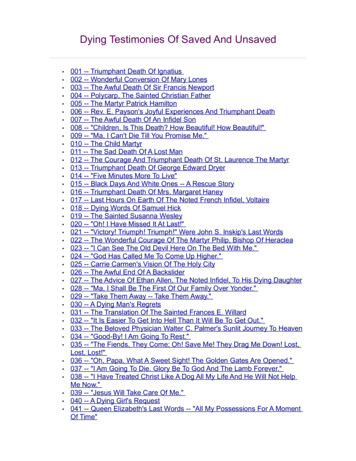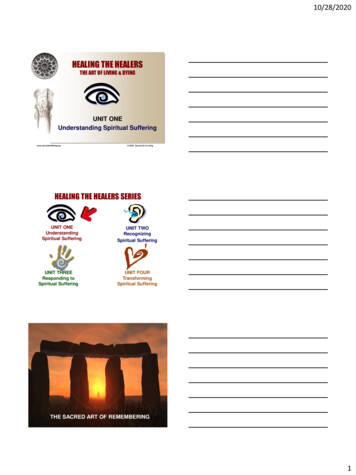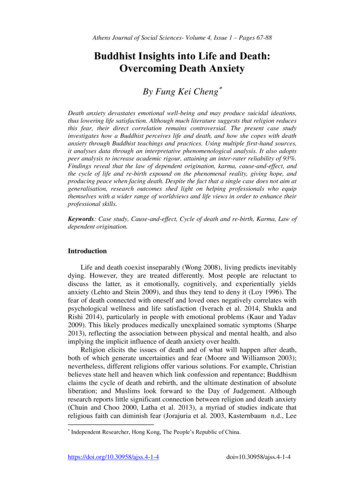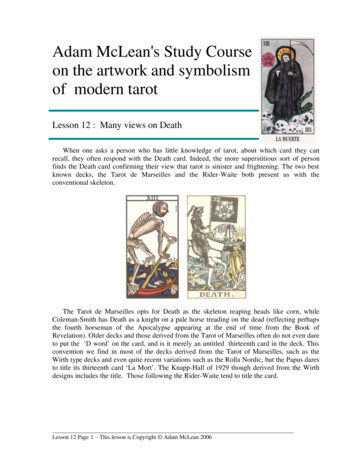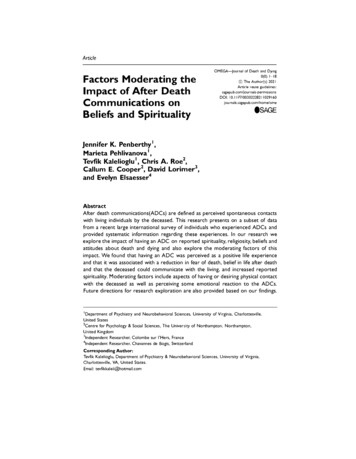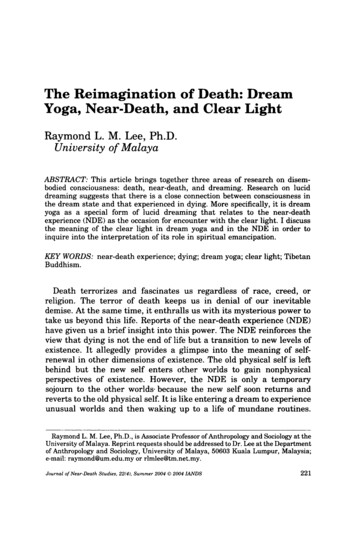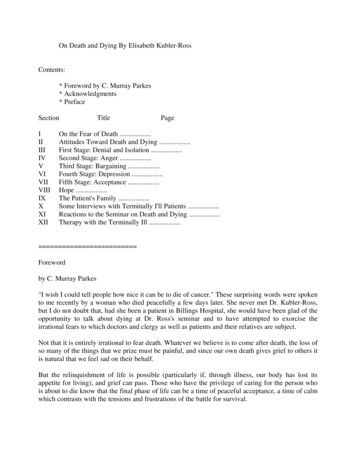
Transcription
On Death and Dying By Elisabeth Kubler-RossContents:* Foreword by C. Murray Parkes* Acknowledgments* n the Fear of Death .Attitudes Toward Death and Dying .First Stage: Denial and Isolation .Second Stage: Anger .Third Stage: Bargaining .Fourth Stage: Depression .Fifth Stage: Acceptance .Hope .The Patient's Family .Some Interviews with Terminally I'll Patients .Reactions to the Seminar on Death and Dying .Therapy with the Terminally Ill . Forewordby C. Murray Parkes I wish I could tell people how nice it can be to die of cancer." These surprising words were spokento me recently by a woman who died peacefully a few days later. She never met Dr. Kubler-Ross,but I do not doubt that, had she been a patient in Billings Hospital, she would have been glad of theopportunity to talk about dying at Dr. Ross's seminar and to have attempted to exorcise theirrational fears to which doctors and clergy as well as patients and their relatives are subject.Not that it is entirely irrational to fear death. Whatever we believe is to come after death, the loss ofso many of the things that we prize must be painful, and since our own death gives grief to others itis natural that we feel sad on their behalf.But the relinquishment of life is possible (particularly if, through illness, our body has lost itsappetite for living), and grief can pass. Those who have the privilege of caring for the person whois about to die know that the final phase of life can be a time of peaceful acceptance, a time of calmwhich contrasts with the tensions and frustrations of the battle for survival.
"Can be"-but, too often, is not. Too many things militate against a fitting approach to death. Despiteall evidence to the contrary, we insist on assuming we are immortal and assuring each other that allof us are on a space walk, immune from the laws of celestial gravity. "Don't worry," says the doctor,"it's only a little ulcer"; "Come now," says the nurse, "You mustn't talk like that, you're going to beall right."A well-rounded life should have a beginning, a middle, and an end. Not just for reasons ofsymmetry but because, though I may be mortal, the social system of which I am a part is immortaland my arrival into and departure from that social system are important events which need to beprepared for. Medicine should not confine itself to the prevention of death any more than familyplanning should confine itself to the prevention of birth. But it is, perhaps, no coincidence that thecentury which produced(VIII)Marie Stopes and Alexander Fleming also produced Grantly Dick Reid and Elisabeth Kubler-Ross.It seems that incipient mortality, though less easy to predict than incipient nativity, is equally aproper matter for preparation and study.Dr. Ross is not alone in her concern for those who are about to die. Important work has been donein Britain by Professor John Hinton and Dr. Cicely Saunders, and already two scientific journalsare appearing in the United States that deal exclusively with matters pertaining to death andbereavement." France too has its "Societe de Thanatologie de la Langue Francaise", whichpublishes a regular Bulletin.But death (like life) is too serious a subject to be taken solemnly, and one of the most cheerful,friendly places I know is a small institution in south London which specializes in the treatment ofcancer patients with a prognosis of six weeks or less. Here the aim is to augment the quality ratherthan the quantity of the life that remains to each patient, and if there are times of sorrow and regretwhen patients and their families face up to the real disappointments that occur, there are also timesof happiness and peace when people stop striving for unreal ends and make a good job of a realending.In this book we shall find described the way in which some American people coped with death.Despite the cultural differences, they are very similar to people in the United Kingdom and there isno need for me to attempt to translate the clear exposition which Dr. Ross has given us. Othersmight (and probably will) adopt a different terminology when describing the phases through whichthe dying patient passes in the course of his illness. Since individual variation is so great, it isunlikely that any one conceptual system could be applied to all. But the overall picture, and theillustrative examples on which it is based, must stand. They stand as a reproach to some, anencouragement to others, and a lesson to all.This book is important reading for nurses, doctors, clergy, and others whose work brings them intocontact with the dying. It is also recommended to any reader who refuses to believe that the bestway to deal with fear is to run away.* One has the awesome title of The Journal of Thanatology and the other Omega.
AcknowledgmentsThere are too many people who have directly or indirectly contributed to this work to express myappreciation to them individually. Dr. Sydney Margolin deserves the credit for having stimulatedthe idea of interviewing terminally ill patients in the presence of students as a meaningful learningteaching model.The Department of Psychiatry at the University of Chicago Billings Hospital has supplied theenvironment and facilities to make such a seminar technically possible.Chaplains Herman Cook and Carl Nighswonger have been helpful and stimulating co-interviewers,who also have assisted in the search for patients at a time when that was immensely difficult.Wayne Rydberg and the original four students by their interest and curiosity have enabled me toovercome the initial difficulties. I was also assisted by the support of the Chicago TheologicalSeminary staff. Reverend Renford Gaines and his wife Harriet have spent countless hoursreviewing the manuscript and have maintained my faith in the worth of this kind of undertaking. Dr.C. Knight Aldrich has supported this work over the past three years.Dr. Edgar Draper and Jane Kennedy reviewed part of the manuscript. Bonita McDaniel, JanetReshkin, and Joyce Carlson deserve thanks for the typing of the chapters.My thanks to the many patients and their families is perhaps best expressed by the publication oftheir communications.There are many authors who have inspired this work, and thanks should be given finally to all thosewho have given thought and attention to the terminally ill.Thanks is given to Mr. Peter Nevraumont for suggesting the writing of this book as well as to Mr.Clement Alexandre, of the Macmillan Company, for his patience and understanding while the bookwas in preparation.(x)Last but not least I wish to thank my husband and my children for their patience and continuedsupport which enables me to carry on a full-time job in addition to being a wife and mother.E. K-R. Preface
When I was asked if I would be willing to write a book on death and dying, I enthusiasticallyaccepted the challenge. When I actually sat down and began to wonder what I had got myself into,it became a different matter. Where do I begin? What do I include? How much can I say tostrangers who are going to read this book, how much can I share from this experience with dyingpatients? How many things are communicated nonverbally and have to be felt, experienced, seen,and can hardly be translated into words?I have worked with dying patients for the past two and a half years and this book will tell about thebeginning of this experiment, which turned out to be a meaningful and instructive experience for allparticipants. It is not meant to be a textbook on how to manage dying patients, nor is it intended asa complete study of the psychology of the dying. It is simply an account of a new and challengingopportunity to refocus on the patient as a human being, to include him in dialogues, to learn fromhim the strengths and weaknesses of our hospital management of the patient. We have asked him tobe our teacher so that we may learn more about the final stages of life with all its anxieties, fears,and hopes. I am simply telling the stories of my patients who shared their agonies, theirexpectations, and their frustrations with us. It is hoped that it will encourage others not to shy awayfrom the "hopelessly" sick but to get closer to them, as they can help them much during their finalhours. The few who can do this will also discover that it can be a mutually gratifying experience;they will learn much about the functioning of the human mind, the unique human aspects of ourexistence, and will emerge from the experience enriched and perhaps with fewer anxieties abouttheir own finality.E. K.-R. (I)On the Fear of DeathLet me not pray to be sheltered from dangersbut to be fearless in facing them.Let me not beg for the stilling of my painbut for the heart to conquer it.Let me not look for allies in life's battlefieldbut to my own strength.Let me not crave in anxious fear to be savedbut hope for the patience to win my freedom.Grant me that 1 may not be a coward,feeling your mercy in my success alone;but let me find the grasp of your hand in my failure.Rabindranath Tagore, Fruit-Gathering
Epidemics have taken a great toll of lives in past generations. Death in infancy and early childhoodwas frequent and there were few families who did not lose a member at an early age. Medicine haschanged greatly in the last decades. Widespread vaccination has practically eradicated manyillnesses, at least in western Europe and the United States. The use of chemotherapy, especially theantibiotics, has contributed to an ever decreasing number of fatalities in infectious diseases. Betterchild care and education have effected a low morbidity and mortality among children. The manydiseases that used to take an impressive toll among the young and middle-aged have beenconquered. The number of old people is on the rise, and, as a result, there is an increasing numberof people with malignancies and chronic diseases associated particularly with old age.Paediatricians have less work with acute and life-threatening situations but they see an everincreasing number of patients suffering from psychosomatic disturbances and from adjustment andbehaviour problems. Physicians have more people in their waiting rooms with emotional problemsthan they have ever had before, but they also have more elderly patients who not only try to livewith their decreased physical abilities and their limitations but who also face loneliness andisolation with all its pains and anguish. The majority of these people are not seen by a psychiatrist.Their needs have to be elicited and gratified by other professional people, for instance, chaplainsand social workers. It is for them that I am trying to outline the changes that have taken place inthe last few decades, changes that are ultimately responsible for an increased fear of death throughunfamiliarity, the rising number of emotional problems, and the greater need for understanding ofand coping with the problems of death and dying.When we look back in time and study former cultures and peoples, we are impressed that death hasalways been distasteful to man and will probably always be. To a psychiatrist this is veryunderstandable and can perhaps best be explained in terms of our understanding of the unconsciousparts of the self; to the unconscious mind, death is never possible in regard to ourselves. It isinconceivable for our unconscious to imagine an actual ending of our own life here on earth, and ifthis life of ours has to end, the ending is always attributed to a malicious intervention from theoutside by someone else. In simple terms, in our unconscious mind we can only be killed; it isinconceivable to die of 1 a natural cause or of old age. Therefore death in itself is associated with abad act, a frightening happening, something that in itself calls for retribution and punishment.One is wise to remember these fundamental facts because they are essential in understanding someof the most important, but otherwise unintelligible, communications of our patients.The second fact that we have to comprehend is that in our unconscious mind we cannot distinguishbetween a wish and a deed. We can all recall illogical dreams in which two completely oppositestatements occur side by side-very acceptable in our dreams but unthinkable in our waking state.just as we, in our unconscious minds cannot differentiate between the wish to kill somebody inanger and the act of killing, so the young child is unable to distinguish between fantasy and reality.The child who angrily wishes his mother to drop dead for not having gratified his needs will betraumatized greatly by her actual death-even if this event is not linked closely in time with hisdestructive wishes. He will always take part or all the blame for the loss of his mother. He willalways say to himself-rarely to others-"I did it, I am responsible, I was bad, therefore Mommy leftme." It is well to remember that the child will react in the same manner if he loses a parent by
divorce, separation, or desertion. Death is often seen by a child as impermanent, and therefore littledistinct from a divorce, after which he may have an opportunity to see a parent again.Many a parent will remember remarks of their children such as, "I will bury my doggy now andnext spring when the flowers come up again, he will get up." Maybe it was the same wish thatmotivated the ancient Egyptians to supply their dead with food and goods to keep them happy andthe old American Indians to bury their relatives with their belongings.When we grow older and begin to realize that our omnipotence is not really so great, that ourstrongest wishes are not powerful enough to make the impossible possible, the fear that we havecontributed to the death of a loved one diminishes-and with it the guilt. The fear remainsdiminished, however, only so long as it is not challenged too strongly. Its vestiges can be seen dailyin hospital corridors and in people associated with the bereaved.A husband and wife may have been fighting for years, but "-hen the partner dies, the survivor willcry and be overwhelmed with regret, fear, and anguish, and will fear his own death more, stillbelieving in the law of talion-an eye for an eye, a tooth for .: tooth-"I am responsible for her death, Iwill have to die a pitiful death in retribution."Maybe this knowledge will help us to understand many of the customs and rituals that endured overthe centuries and whose purpose is to diminish the anger of the gods or society, as the case may be,thus decreasing the anticipated punishment. I think of the ashes, the torn clothes, the veil, the KlageWeiber of the old days-they are all means of asking others to take pity on them, the mourners, andare expressions of sorrow, grief, and shame. A person who grieves, beats his breast, tears his hair,or refuses to eat, is attempting self-punishment to avoid or reduce the anticipated externalpunishment for the blame he expects on the death of a loved one.The grief, shame, and guilt are not very far removed from feelings of anger and rage. The processof grief always includes some elements of anger. Since none of us likes to admit anger at adeceased person, these emotions are often disguised or repressed, and prolong the period of grief,or show up in other ways. It is well to remember that it is not up to us to judge such feelings as bador shameful but to understand their true meaning and origin as something very human. In order toillustrate this I will again use the example of the child-and the child in us all. The fiveyear-old wholoses his mother is both blaming himself for her disappearance and expressing anger at her forhaving deserted him and for no longer gratifying his needs. The dead person then turns intosomething the child loves and wants very much, but also hates with equal intensity for this severedeprivation.The ancient Hebrews regarded the body of a dead person as something unclean and not to betouched. The early American Indians talked about evil spirits, and shot arrows into the air to drivethe spirits away. Many other cultures have rituals to take care of the "bad" dead person, and they alloriginate in this feeling of anger which still exists in all of us, though we dislike admitting it. Thetradition of the tombstone may originate in this wish to keep the bad spirits deep down in theground, and the pebbles that many mourners put on the grave are left-over symbols of the samewish. Though we call the firing of guns at military funerals a last salute, it is, perhaps, the samesymbolic ritual as the Indian used when he shot his spears and arrows into the skies.
I give these examples to emphasize that man has not basically changed. Death is still a fearful,frightening happening, and the fear of death is a universal fear even if we think we have mastered iton many levels.What has changed is our way of coping and dealing with death and dying and with our dyingpatients.Having been raised in a country in Europe where science is not so advanced, where moderntechniques have just started to find their way into medicine, and where people still live as they didin this country half a century ago, I may have had an opportunity to study a part of the evolution ofmankind in a telescoped form.I remember, as a child, the death of a farmer. He fell from a tree and was not expected to live. Heasked simply to die at home, a wish that was granted without questioning. He called his daughtersinto the bedroom and spoke with each one of them alone for a few minutes. He arranged his affairsquietly, though he was in great pain, and distributed his belongings and his land, none of which wasto be split until his wife should follow him in death. He also asked each of his children to share inthe work, duties, and tasks that he had carried on until the time of the accident. He asked his friendsto visit him once more, to bid good-bye to them. Although I was a small child at the rime, he didnot exclude me or my siblings. We were allowed to share in the preparations of the family just aswe were permitted to grieve with them until he died. When he did die, he was left in his own home,which he had built, and among his friends and neighbors who went to take a last look at him wherehe lay in the midst of flowers in the place he had lived in and loved so. In that country today thereis still no make-believe slumber room, no embalming, no false make-up to pretend sleep. Only thesigns of very disfiguring illnesses are covered up with bandages and only infectious cases areremoved from the home prior to the burial.Why do I describe such "old-fashioned" customs? I think they are an indication of our acceptanceof a fatal outcome, and they help the dying patient as well as his family to accept the loss of a lovedone. If a patient is allowed to terminate his life in the familiar and beloved environment, lessadjustment is required of him. His own family knows him well enough to replace a sedative with aglass of his favourite wine; or the smell of a homecooked soup may give him the appetite to sip afew spoons of fluid which, I think, is still more enjoyable than an infusion. I do not minimize theneed for sedatives and infusions and realize full well from my own experience as a country doctorthat they are sometimes life-saving and often unavoidable. But I also know that patience andfamiliar people and foods could replace manya bottle of intravenous fluids given for the simple reason that it fulfills the physiological needwithout involving too many people and/or individual nursing care.The fact that children are allowed to stay at home where a fatality has struck and are included in thetalk, discussions, and fears, gives them the feeling that they are not alone in grief and offers themthe comfort of shared responsibility and shared mourning. It prepares them gradually and helpsthem to view death as part of life, an experience that may help them to grow and mature.This is in great contrast to a society in which death is viewed as taboo, discussion of it is regardedas morbid, and children are excluded with the presumption and pretext that it would be "too much"
for them. They are then sent off to relatives, often to the accompaniment of some unconvincing liethat "Mother has gone on a long trip" or other unbelievable stories. The child senses that somethingis wrong, and his distrust of adults will only grow if other relatives add new variations to the story,avoid his questions or suspicions, and shower him with gifts as a substitute for a loss he is notpermitted to deal with. Sooner or later the child will become aware of the changed family situationand, according to his age and personality, will suffer an unresolved grief that he has no means ofcoping with. For him, the episode is a mysterious and frightening experience of untrustworthygrownups, which can only be traumatic.It is equally unwise to tell a child who has lost her brother that God loves little boys so much thathe took Johnny to heaven. When one such little girl grew up to be a woman she never resolved heranger at God, which resulted in a psychotic depression when she lost her own little son threedecades later.We would think that our great emancipation, our knowledge of science and of man, had given usbetter ways and means to prepare ourselves and our families for this inevitable happening. Insteadthe days are gone when a man was allowed to die in peace and dignity in his own home.The more we are achieving advances in science, the more we seem to fear and deny the reality ofdeath. How is this possible?We use euphemisms, we make the dead look as if they were asleep, we ship the children off toprotect them from the anxietyand turmoil around the house if the patient is fortunate enough to die at home, we do not allowchildren to visit their dying parents in the hospitals, we have long and controversial discussionsabout whether patients should be told the truth-a question that rarely arises when the dying personis tended by the family physician, who has known him from delivery to death and who understandsthe weaknesses and strengths of each member of the family.I think there are many reasons for this flight from facing death calmly. One of the most importantfacts is that dying nowadays is in many ways more gruesome, more lonely, mechanical, anddehumanized; at times it is even difficult to determine technically when the moment of death hasoccurred.Dying becomes lonely and impersonal because the patient is Often taken out of his familiarenvironment and rushed to an emergency ward. Anyone who has been very sick and has desiredrest and comfort may recall his experience of being put on a stretcher and especially of enduringthe noise of the ambulance siren and the hectic rush to hospital. Only those who have lived throughthis may appreciate the discomfort of such transportation, which is only the beginning of a longordeal-hard to endure ,.%,hen you are well; difficult to express in words when noise, light, ;pimps,and voices are all too much to bear. It may well be that we should consider more carefully thepatient himself and perhaps stop our well-intentioned rush in order to hold the patient's hand, tosmile, or to listen to a question. I consider the trip to the Hospital as the first episode in dying, as itis for many. I put it starkly not in order to deny that lives should be saved if they can 1,e saved by ahospitalization but to keep the focus on the patients experience, his needs, and his reactions.
When a patient is severely ill, he is often treated like a person with no right to an opinion. It is oftensomeone else who makes :he decision if and when and where a patient should be hospitalized. Itwould take so little to remember that the sick person too has feelings, wishes, and opinions, andhas-most important of all-the right to be heard.Well, our imaginary patient has now reached the emergency ward. He will be surrounded by busynurses, orderlies, interns, residents, a lab technician perhaps who will take some blood,another technician who takes the electrocardiogram. He may be moved to X-ray and he willoverhear opinions of his condition and discussions and questions to members of the family. Slowlybut surely he is beginning to be treated like a thing. He is no longer a person. Decisions are madeoften without taking his opinion. If he tries to rebel he will b e sedated, and after hours of waitingand wondering whether he has the strength, he will be wheeled into the operating room or intensivetreatment unit and become an object of great concern and great financial investment.He may cry out for rest, peace, dignity, but he will get infusions, transfusions, a heart machine, or atracheostomy. He may want one single person to stop for one single minute so that he can ask onesingle question-but he will get a dozen people around the clock, all busily preoccupied with hisheart rate, pulse, electrocardiogram or pulmonary functions, his secretions or excretions, but notwith him as a human being. He may wish to fight it all but it is going to be a useless fight since allthis is done in the fight for his life, and if they can save his life they can consider the personafterwards. Those who consider the person first may lose precious time to save his life! At least thisseems to be the rationale or justification behind all this-or is it? Is the reason for this increasinglymechanical, depersonalized approach our own defensiveness? Is this approach our own way to copewith and repress the anxieties that a terminally or critically ill patient evokes in us? Is ourconcentration on equipment, on blood pressure, our desperate attempt to deny the impending end,which is so frightening and discomforting to us that we displace all our knowledge onto machines,since they are less close to us than the suffering face of another human being, which would remindus once more of our lack of omnipotence, our own limitations and fallibility and, last but not leastperhaps, our own mortality?Maybe the question has to be raised: Are we becoming less human or more human? Though thisbook is in no way meant to be judgmental, it is clear that whatever the answer may be, the patient issuffering more-not physically, perhaps, but emotionally. And his needs have not changed over thecenturies, only our capacity to gratify them. IIAttitudes Toward Death and DyingMen are cruel,but Man is kind.
Tagore, from Stray Birds, CCXIXSociety's Contributions to DefensivenessUntil now we have looked at the individual human reaction to death and dying. If we now take alook at our society, we may want to ask ourselves what happens to man in a society bent onignoring or avoiding death. What factors, if any, contribute to an increasing anxiety in relation todeath? What happens in a changing field of medicine, where we have to ask ourselves whethermedicine is to remain a humanitarian and respected profession or a new but depersonalized sciencein the service of prolonging life rather than diminishing human suffering? Where the medicalstudents have a choice of dozens of lectures on RNA and DNA but less experience in the simpledoctor-patient relationship that used to be the alphabet for every successful family physician? Whathappens in a society that puts more emphasis on IQ and class-standing than on simple matters oftact, sensitivity, perceptiveness, and good taste in the management of the suffering? In aprofessional society where the young medical student is admired for his research and laboratorywork during the first years of medical school while he is at a loss for words when a patient asks hima simple question? If we could combine the teaching of the new scientific and technicalachievements with equal emphasis on interpersonal human relationships10we would indeed make progress, but not if the new knowledge is conveyed to the student at theprice of less and less interpersonal contact. What is going to become of a society which puts theemphasis on numbers and masses, rather than on the individual-where medical schools hope toenlarge their classes, where the trend is away from the teacher-student contact, which is replaced byclosed-circuit television teaching, recordings, and movies, all of which can teach a greater numberof students in a snore depersonalized manner?This change of focus from the individual to the masses has been more dramatic in other areas ofhuman interaction. If we take a look at the changes that have taken place in the last decades, we cannotice it everywhere. In the old days a man was able to face his enemy eye to eye. He had a fairchance in a personal encounter with a visible enemy. Now the soldier as well as the civilian has toanticipate weapons of mass destruction which offer no one a reasonable chance, often not even anawareness of their approach. Destruction can strike out of the blue skies and destroy thousands likethe bomb at Hiroshima; it may come in the form of gases or other means of chemical warfareinvisible crippling, killing. It is no longer the man who fights for his rights, his convictions, or thesafety or honor of his family, it is the nation including its women and children who are in the waraffected directly or indirectly without a chance of survival. This is how science and technologyhave contributed to an ever increasing fear of destruction and therefore fear of death.Is it surprising, then, that man has to defend himself more? If his ability to defend himselfphysically is getting smaller and smaller, his psychological defenses have to increase manifoldly.He cannot maintain denial forever. He cannot continuously and successfully pretend that he is
the dying patient passes in the course of his illness. Since individual variation is so great, it is unlikely that any one conceptual system could be applied to all. But the overall picture, and the illustrative examples on which it is based, must stand. They stand as a reproach to some, an encou
